在 AMQP 中,Producer 将消息发送到 Exchange ,再由 Exchange 将消息路由到一个或多个 Queue 中(或者丢弃)。Exchange 根据 Routing Key 和 Binding Key 将消息路由到 Queue ,目前提供了 Direct、Topic、Fanout、Headers 四种类型。
RabbitMQ 概念
A. Queue
Queue: Queue(队列)是RabbitMQ的内部对象,用于存储消息,RabbitMQ 中的消息都只能存储在 Queue 中,生产消息并最终投递到Queue中, 消费者可以从Queue中获取消息并消费
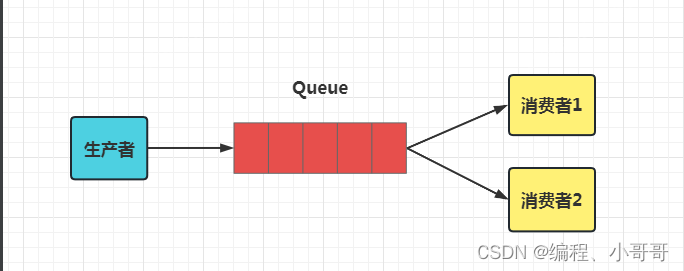
B. Exchange
Exchange: 交换器,实际上这在 RabbitMQ 中是不会生产者将消息投递到队列中,而是,生产者将消息发送到Exchange(交换器),由Exchange将消息路由到一个或多个Queue中(或者丢弃)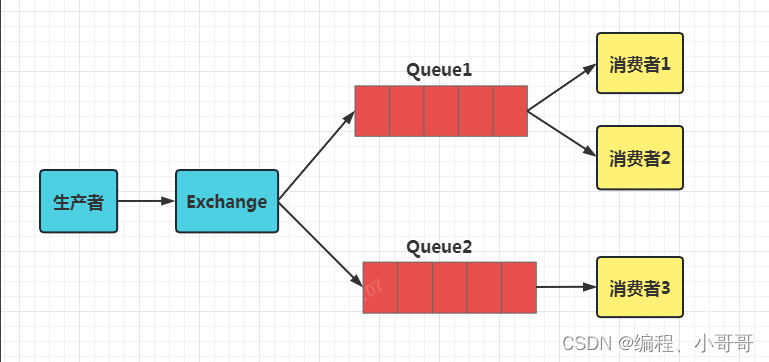
C. Routing key
Routing key: 生产者在将消息发送给Exchange的时候,一般会指定一个routing key,来指定这个消息的路由规则,而这个routing key需要与Exchange Type及binding key联合使用才能最终生效。 在Exchange Type与binding key固定的情况下(在正常使用时一般这些内容都是固定配置好的),我们的生产者就可以在发送消息给Exchange时,通过指定routing key来决定消息流向哪里。 RabbitMQ为routing key设定的长度限制为255 bytes。
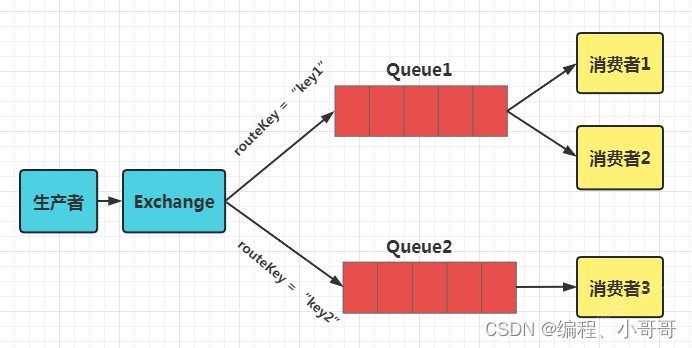
D. Binding
Binding: RabbitMQ中通过Binding将Exchange与Queue关联起来,这样RabbitMQ就知道如何正确地将消息路由到指定的Queue了。
E. Binding key
Binding key: 在绑定(Binding)Exchange与Queue的同时,一般会指定一个binding key;消费者将消息发送给Exchange时,一般会指定一个routing key;当binding key与routing key相匹配时,消息将会被路由到对应的Queue中。这个将在Exchange Types章节会列举实际的例子加以说明。 在绑定多个Queue到同一个Exchange的时候,这些Binding允许使用相同的binding key。 binding key 并不是在所有情况下都生效,它依赖于Exchange Type,比如fanout类型的Exchange就会无视binding key,而是将消息路由到所有绑定到该Exchange的Queue。
交换机类型
- Direct Exchange
Direct 类型的 Exchange 路由规则比较简单,它会把消息路由到那些 binding key 与 routing key 完全匹配的 Queue 中
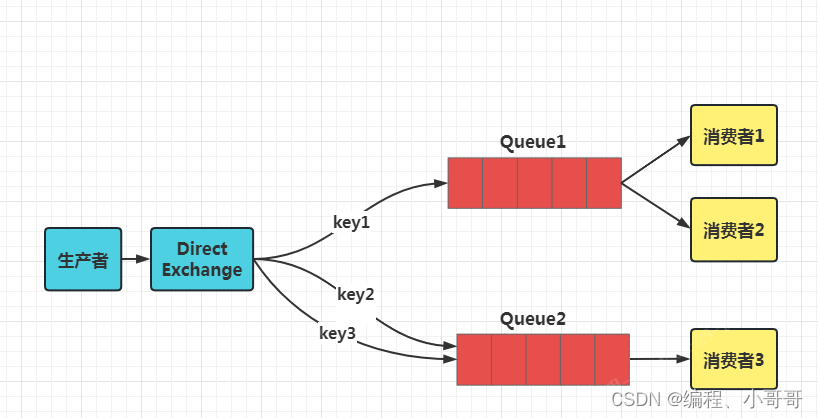
我们以 routingKey=“key1” 发送消息到 Direct Exchange ,则消息会路由到 Queue1
我们以 routingKey=“key2” 或者 routingKey=“key3” 发送消息到 Direct Exchange ,则消息会路由到 Queue2
如果我们以其它 routingKey 发送消息,则消息不会路由到这两个 Queue 中。
2. Topic Exchange
Direct Exchange路由规则,是完全匹配 binding key 与routing key,但这种严格的匹配方式在很多情况下不能满足实际业务需求。 Topic Exchange 在匹配规则上进行了扩展,它与 Direct 类型的Exchange 相似,也是将消息路由到 binding key 与 routing key 相匹配的 Queue 中,但这里的匹配规则有些不同,它约定:
routing key 为一个句点号 “.” 分隔的字符串。我们将被句点号"."分隔开的每一段独立的字符串称为一个单词,例如 “pay.order.key”
binding key 与 routing key 一样也是句点号 “.” 分隔的字符串。
binding key 中可以存在两种特殊字符 * 与 #,用于做模糊匹配。其中 * 用于匹配一个单词,# 用于匹配多个单词(可以是零个)。
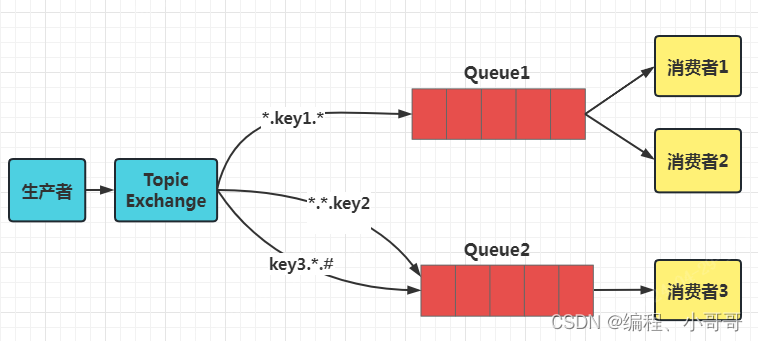
以上图为例
routingKey=“xx.key1.yy” 的消息会同时路由到 Q1 。
routingKey=“xx.key1.key2” 的消息会同时路由到 Q1 与 Q2 。
routingKey=“xx.yy.key2” 的消息会路由到 Q2 。
routingKey=“key3.xx.key2” 的消息会路由到Q2(只会投递给 Q2 一次,虽然这个 routingKey 与 Q2 的两个 bindingKey 都匹配)。
routingKey=“xx.yy.zz”、routingKey=“key1”、routingKey=“xx.key1.zz.key2” 的消息将会被丢弃,因为它们没有匹配任何 bindingKey 。
3. Fanout Exchange
Fanout Exchange 路由规则非常简单,它会把所有发送到该 Exchange 的消息路由到所有与它绑定的 Queue 中
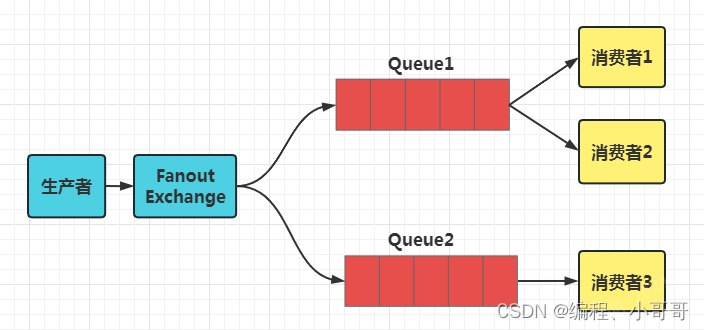
生产者发送到 Exchange 的所有消息都会路由到图中的两个 Queue,并最终被消费者消费。
总结来说,指定 Exchange ,会路由到多个绑定的 Queue 中。
4. Headers Exchange
Headers Exchange 不依赖于 routing key 与 binding key 的匹配规则来路由消息,而是根据发送的消息内容中的 headers 属性进行匹配。
在绑定 Queue 与 Exchange 时指定一组 headers 键值对。
当消息发送到 Exchange 时,RabbitMQ 会取到该消息的 headers(也是一个键值对的形式),对比其中的键值对是否完全匹配 Queue 与 Exchange 绑定时指定的键值对;如果完全匹配则消息会路由到该 Queue ,否则不会路由到该 Queue 。
下面进行实战操作
A:Direct模式
confi配置类
@Configuration
public class DirectExchangeConfiguration {
/**
* 创建一个 Queue
*
* @return Queue
*/
@Bean
public Queue queue01() {
// Queue:名字 | durable: 是否持久化 | exclusive: 是否排它 | autoDelete: 是否自动删除
return new Queue(
Message01.QUEUE,
true,
false,
false);
}
/**
* 创建 Direct Exchange
*
* @return DirectExchange
*/
@Bean
public DirectExchange exchange01() {
// name: 交换机名字 | durable: 是否持久化 | exclusive: 是否排它
return new DirectExchange(Message01.EXCHANGE,
true,
false);
}
/**
* 创建 Binding
* Exchange:Message01.EXCHANGE
* Routing key:Message01.ROUTING_KEY
* Queue:Message01.QUEUE
*
* @return Binding
*/
@Bean
public Binding binding01() {
return BindingBuilder
.bind(queue01()).to(exchange01())
.with(Message01.ROUTING_KEY);
}
}
====================================》direct 类型的消息对象
@Data
public class Message01 implements Serializable {
public static final String QUEUE = "QUEUE_01";
public static final String EXCHANGE = "EXCHANGE_01";
public static final String ROUTING_KEY = "ROUTING_KEY_01";
private String id;
}
===============================>生产者
@Component
public class Producer01 {
@Resource
private RabbitTemplate rabbitTemplate;
public void syncSend(String id) {
// 创建 Message01 消息
Message01 message = new Message01();
message.setId(id);
// 同步发送消息
rabbitTemplate.convertAndSend(Message01.EXCHANGE, Message01.ROUTING_KEY, message);
}
public void syncSendDefault(String id) {
// 创建 Message01 消息
Message01 message = new Message01();
message.setId(id);
// 同步发送消息
rabbitTemplate.convertAndSend(Message01.QUEUE, message);
}
@Async
public ListenableFuture<Void> asyncSend(String id) {
try {
// 发送消息
this.syncSend(id);
// 返回成功的 Future
return AsyncResult.forValue(null);
} catch (Throwable ex) {
// 返回异常的 Future
return AsyncResult.forExecutionException(ex);
}
}
==============================================>消费者
@Component
@RabbitListener(queues = Message01.QUEUE)
@Slf4j
public class Consumer01 {
public void onMessage(Message01 message) {
log.info("[Consumer01 onMessage][线程编号:{} 消息内容:{}]", Thread.currentThread().getId(), message);
}
}
======================================》direct的测试类
@Resource
Producer01 producer01;
@SneakyThrows
@Test
void syncSend() {
String id = UUID.randomUUID().toString();
producer01.syncSend(id);
log.info("[test producer01 syncSend][id:{}] 发送成功", id);
TimeUnit.SECONDS.sleep(2);
}
@Test
void syncSendDefault() throws InterruptedException {
String id = UUID.randomUUID().toString();
producer01.syncSendDefault(id);
log.info("[test producer01 syncSendDefault][id:{}] 发送成功", id);
TimeUnit.SECONDS.sleep(2);
}
@Test
void asyncSend() throws InterruptedException {
String id = UUID.randomUUID().toString();
producer01.asyncSend(id).addCallback(new ListenableFutureCallback<Void>() {
@Override
public void onFailure(Throwable e) {
log.info("[testASyncSend][发送编号:[{}] 发送异常]]", id, e);
}
@Override
public void onSuccess(Void aVoid) {
log.info("[testASyncSend][发送编号:[{}] 发送成功,发送成功]", id);
}
});
log.info("[test producer01 asyncSend][id:{}] 发送成功", id);
TimeUnit.SECONDS.sleep(2);
}
B:Fanout 扇出 广播模式
==============》Fanout Exchange 示例的配置类
@Configuration
public class FanoutExchangeConfiguration {
/**
* 创建 Queue A
*
* @return Queue
*/
@Bean
public Queue queue03A() {
// Queue:名字 | durable: 是否持久化 | exclusive: 是否排它 | autoDelete: 是否自动删除
return new Queue(Message03.QUEUE_A,
true,
false,
false);
}
/**
* 创建 Queue B
*
* @return Queue
*/
@Bean
public Queue queue03B() {
return new Queue(Message03.QUEUE_B,
true,
false,
false);
}
/**
* 创建 Fanout Exchange
*
* @return FanoutExchange
*/
@Bean
public FanoutExchange demo03Exchange() {
// name: 交换机名字 | durable: 是否持久化 | exclusive: 是否排它
return new FanoutExchange(Message03.EXCHANGE,
true,
false);
}
/**
* 创建 Binding A
* Exchange:Message03.EXCHANGE
* Queue:Message03.QUEUE_A
*
* @return Binding
*/
@Bean
public Binding demo03BindingA() {
return BindingBuilder
.bind(queue03A()).to(demo03Exchange());
}
/**
* 创建 Binding B
* Exchange:Message03.EXCHANGE
* Queue:Message03.QUEUE_B
*
* @return Binding
*/
@Bean
public Binding demo03BindingB() {
return BindingBuilder
.bind(queue03B()).to(demo03Exchange());
}
============================》Fanout Exchange 类型消息
@Data
public class Message03 implements Serializable {
public static final String QUEUE_A = "QUEUE_03_A";
public static final String QUEUE_B = "QUEUE_03_B";
public static final String EXCHANGE = "EXCHANGE_03";
private String id;
}
==============================》生产者
@Component
public class Producer03 {
@Resource
private RabbitTemplate rabbitTemplate;
/**
* @param id 消息内容
* @param routingKey key
*/
public void syncSend(String id) {
Message03 message = new Message03();
message.setId(id);
rabbitTemplate.convertAndSend(Message03.EXCHANGE, null, message);
}
==============================》消费者
@Component
@Slf4j
public class Consumer03 {
@RabbitListener(queues = Message03.QUEUE_A)
public void onMessage1(Message03 message) {
log.info("[Consumer03 onMessage1][线程编号:{} 消息内容:{}]", Thread.currentThread().getId(), message);
}
@RabbitListener(queues = Message03.QUEUE_B)
public void onMessage2(Message03 message) {
log.info("[Consumer03 onMessage2][线程编号:{} 消息内容:{}]", Thread.currentThread().getId(), message);
}
}
=====================================》Fanout Exchange 测试类
@Resource
Producer03 producer03;
@Test
void syncSend() throws InterruptedException {
String id = UUID.randomUUID().toString();
producer03.syncSend(id);
log.info("[test producer03 syncSend][id: {}] 发送成功", id);
TimeUnit.SECONDS.sleep(2);
}
C:Topic 主题模式
========================》TopicExchange 配置
@Configuration
public class TopicExchangeConfiguration {
/**
* 创建 Queue
*
* @return Queue
*/
@Bean
public Queue queue02() {
// Queue:名字 | durable: 是否持久化 | exclusive: 是否排它 | autoDelete: 是否自动删除
return new Queue(Message02.QUEUE,
true,
false,
false);
}
/**
* 创建 Topic Exchange
*
* @return TopicExchange
*/
@Bean
public TopicExchange exchange02() {
// name: 交换机名字 | durable: 是否持久化 | exclusive: 是否排它
return new TopicExchange(Message02.EXCHANGE,
true,
false);
}
/**
* 创建 Binding
* Exchange:Message02.EXCHANGE
* Routing key:Message02.ROUTING_KEY
* Queue:Message02.QUEUE
*
* @return Binding
*/
@Bean
public Binding binding02() {
return BindingBuilder
.bind(queue02()).to(exchange02())
.with(Message02.ROUTING_KEY);
}
===========================================》topic 类型的实体类
@Data
public class Message02 implements Serializable {
public static final String QUEUE = "QUEUE_02";
public static final String EXCHANGE = "EXCHANGE_02";
public static final String ROUTING_KEY = "#.key2.key3";
private String id;
}
==============================================》生产者 topic 类型
@Component
public class Producer02 {
@Resource
private RabbitTemplate rabbitTemplate;
/**
* @param id 消息内容
* @param routingKey key
*/
public void syncSend(String id, String routingKey) {
Message02 message = new Message02();
message.setId(id);
rabbitTemplate.convertAndSend(Message02.EXCHANGE, routingKey, message);
}
}
===================================》 topic 消费者
@Component
@RabbitListener(queues = Message02.QUEUE)
@Slf4j
public class Consumer02 {
@RabbitHandler
public void onMessage(Message02 message) {
log.info("[Consumer02 onMessage][线程编号:{} 消息内容:{}]", Thread.currentThread().getId(), message);
}
}
=============================================》topic测试类
@Resource
Producer02 producer02;
@Test
void syncSendSuccess1() throws InterruptedException {
String id = UUID.randomUUID().toString();
// 必须要满足 routingKey 规则才能够成功投递
String routingKey = "aa.key2.key3";
producer02.syncSend(id, routingKey);
log.info("[test producer02 syncSendSuccess1][routingKey: {}][id: {}] 发送成功", routingKey, id);
TimeUnit.SECONDS.sleep(2);
}
@Test
void syncSendSuccess2() throws InterruptedException {
String id = UUID.randomUUID().toString();
String routingKey = "aa.bb.key2.key3";
producer02.syncSend(id, routingKey);
log.info("[test producer02 syncSendSuccess2][routingKey: {}][id: {}] 发送成功", routingKey, id);
TimeUnit.SECONDS.sleep(2);
}
@Test
void syncSendFail() throws InterruptedException {
String id = UUID.randomUUID().toString();
String routingKey = "aa.key2.zz";
producer02.syncSend(id, routingKey);
log.info("[test producer02 syncSendFail][routingKey:{}][id:{}] 发送成功", routingKey, id);
TimeUnit.SECONDS.sleep(2);
}
以上的是入门的基础的常见部分代码 若需完整代码 可识别二维码后 给您发代码。






